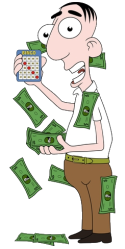 Winning At Bingo Made Easy!
Winning At Bingo Made Easy!
 The popular misconception regarding the game of Bingo states that in order to win, all you need is sheer luck. However, the truth is that Bingo is a game of chance, which means that the outcome is subjected to the laws of probability.
The popular misconception regarding the game of Bingo states that in order to win, all you need is sheer luck. However, the truth is that Bingo is a game of chance, which means that the outcome is subjected to the laws of probability.
Among the first people to devise strategies that will be able to tilt the odds in a Bingo player’s favor, Joseph E. Granville is probably the most famous. A mathematical analyst who is also responsible for numerous effective strategies in predicting the changes of the capricious stock exchange market, Granville has shown us that patterns do in fact exist in the seemingly random game of Bingo and following them is instrumental in winning. Let’s elaborate a little more.
Standard games comprise of several draws from the 75 ball pool up to the point when one of the players has successfully completed his card. For the first ball to be withdrawn from the urn at random, the chances are 1 in 75. Basically, the first ball can have any number from 1 to 75, a concept which is referred to as uniform distribution. The uniform distribution is in fact the reason why Granville considers the patterns can be predicted and here is why.
The rules governing an uniform distribution in this case state that during the typical 12 ball extraction, an equal amount of balls ending with each digit (1,2,3,4,5,6,7,8,9,0) should be present. In addition, there should also be similar amounts of both even and odd numbered balls and an equal amount of high and low figures. These 3 laws have been proven statistically and are accepted in mathematics. An additional rule that applies particularly well to the game of Bingo has been discovered by Tippett and is known as sampling.
To put it in simple terms, Tippett shows that increasing the size of random samples determines results which gradually approach the average population value, which in the case of Bingo is 38. The probability that the first numbers drawn from the urn are averaging this value are limited, but when the game of Bingo progresses, they increase substantially. Derived from the first rule of probability shown by Granville, or rather as an explanation for it, the probability that a number ending with a digit will be extracted twice is very low. How so? Simply because there are fewer numbers with that mathematical property among the population, which makes the event less probable.
These laws may appear clear if you examine the master board, but most players tend to focus their attention on their own score boards – some utilize more in order to increase their chances, which statistically is a mistake – overlooking the big picture. Therefore, keep that in mind the next time you choose your bingo cards.

